Impact of Conditioning Agent Addition Sequence on Dewatering Performance of Advanced Anaerobic Digested Sludge
Abstract
1. Introduction
2. Materials and Methods
2.1. Sludge Samples and Chemicals
2.2. Digested Sludge Conditioning and Dewatering
2.3. Physicochemical Properties of Sludge
2.3.1. Extracellular Polymeric Substance (EPS) Extraction and Analysis
2.3.2. Basic Characteristics of the Sludge
2.3.3. Morphological Analysis
2.3.4. Rheological Experiments
3. Results and Discussion
3.1. Determination of the Optimal Conditioning Agent Conditioning Conditions
3.2. Effect of Pretreatment on Sludge Dewatering Performance Based on Particle Size and Solids Content
3.3. Composition of EPS
3.4. Zeta Potential and Particle Size
3.5. Morphological Characteristics of Flocs
3.6. Sludge Rheology Curves
3.7. Mechanistic Analysis of Dehydration Performance
4. Conclusions
Author Contributions
Funding
Data Availability Statement
Acknowledgments
Conflicts of Interest
References
- Zhen, G.; Lu, X.; Wang, B.; Zhao, Y.; Chai, X.; Niu, D.; Zhao, A.; Li, Y.; Song, Y.; Cao, X. Synergetic Pretreatment of Waste Activated Sludge by Fe(II)–Activated Persulfate Oxidation under Mild Temperature for Enhanced Dewaterability. Bioresour. Technol. 2012, 124, 29–36. [Google Scholar] [CrossRef]
- Padervand, M.; Lichtfouse, E.; Robert, D.; Wang, C. Removal of microplastics from the environment. A review. Environ. Chem Lett. 2020, 18, 807–828. [Google Scholar] [CrossRef]
- Alarcon, P.C.; Kitanovski, Z.; Padervand, M.; Pöschl, U.; Lammel, G.; Zetzsch, C. Atmospheric Hydroxyl Radical Reaction Rate Coefficient and Total Environmental Lifetime of α-Endosulfan. Environ. Sci. Technol. 2023, 57, 15999–16005. [Google Scholar] [CrossRef]
- Hyrycz, M.; Ochowiak, M.; Krupińska, A.; Włodarczak, S.; Matuszak, M. A Review of Flocculants as an Efficient Method for Increasing the Efficiency of Municipal Sludge Dewatering: Mechanisms, Performances, Influencing Factors and Perspectives. Sci. Total Environ. 2022, 820, 153328. [Google Scholar] [CrossRef] [PubMed]
- Di Capua, F.; Spasiano, D.; Giordano, A.; Adani, F.; Fratino, U.; Pirozzi, F.; Esposito, G. High-Solid Anaerobic Digestion of Sewage Sludge: Challenges and Opportunities. Appl. Energy 2020, 278, 115608. [Google Scholar] [CrossRef]
- Yu, B.; Xu, J.; Yuan, H.; Lou, Z.; Lin, J.; Zhu, N. Enhancement of Anaerobic Digestion of Waste Activated Sludge by Electrochemical Pretreatment. Fuel 2014, 130, 279–285. [Google Scholar] [CrossRef]
- Zhang, Q.; Vlaeminck, S.E.; DeBarbadillo, C.; Su, C.; Al-Omari, A.; Wett, B.; Pümpel, T.; Shaw, A.; Chandran, K.; Murthy, S.; et al. Supernatant Organics from Anaerobic Digestion after Thermal Hydrolysis Cause Direct and/or Diffusional Activity Loss for Nitritation and Anammox. Water Res. 2018, 143, 270–281. [Google Scholar] [CrossRef]
- Wu, Y.Q.; Jiang, Y.H. Comparison of dewatering performance of residual sludge and anaerobically digested sludge. China Water Supply Drain. 2018, 34, 82–85. [Google Scholar] [CrossRef]
- Mahmoud, A.; Olivier, J.; Vaxelaire, J.; Hoadley, A.F.A. Advances in Mechanical Dewatering of Wastewater Sludge Treatment. In Wastewater Reuse and Management; Sharma, S.K., Sanghi, R., Eds.; Springer: Dordrecht, The Netherlands, 2013; pp. 253–303. [Google Scholar] [CrossRef]
- Cieślik, B.M.; Namieśnik, J.; Konieczka, P. Review of Sewage Sludge Management: Standards, Regulations and Analytical Methods. J. Clean. Prod. 2015, 90, 1–15. [Google Scholar] [CrossRef]
- Guan, R.; Yuan, X.; Wu, Z.; Wang, H.; Jiang, L.; Li, Y.; Zeng, G. Functionality of Surfactants in Waste-Activated Sludge Treatment: A Review. Sci. Total Environ. 2017, 609, 1433–1442. [Google Scholar] [CrossRef]
- Liu, J.; Wei, Y.; Li, K.; Tong, J.; Wang, Y.; Jia, R. Microwave-Acid Pretreatment: A Potential Process for Enhancing Sludge Dewaterability. Water Res. 2016, 90, 225–234. [Google Scholar] [CrossRef]
- Mowla, D.; Tran, H.N.; Allen, D.G. A Review of the Properties of Biosludge and Its Relevance to Enhanced Dewatering Processes. Biomass Bioenergy 2013, 58, 365–378. [Google Scholar] [CrossRef]
- Raynaud, M.; Vaxelaire, J.; Olivier, J.; Dieudé-Fauvel, E.; Baudez, J.-C. Compression Dewatering of Municipal Activated Sludge: Effects of Salt and PH. Water Res. 2012, 46, 4448–4456. [Google Scholar] [CrossRef] [PubMed]
- Haydar, S.; Aziz, J.A. Coagulation–Flocculation Studies of Tannery Wastewater Using Combination of Alum with Cationic and Anionic Polymers. J. Hazard. Mater. 2009, 168, 1035–1040. [Google Scholar] [CrossRef] [PubMed]
- Wang, H.-F.; Ma, Y.-J.; Wang, H.-J.; Hu, H.; Yang, H.-Y.; Zeng, R.J. Applying Rheological Analysis to Better Understand the Mechanism of Acid Conditioning on Activated Sludge Dewatering. Water Res. 2017, 122, 398–406. [Google Scholar] [CrossRef] [PubMed]
- Wang, Q.; Zhang, W.; Yang, Z.; Xu, Q.; Yang, P.; Wang, D. Enhancement of Anaerobic Digestion Sludge Dewatering Performance Using In-Situ Crystallization in Combination with Cationic Organic Polymers Flocculation. Water Res. 2018, 146, 19–29. [Google Scholar] [CrossRef] [PubMed]
- Farno, E.; Baudez, J.C.; Parthasarathy, R.; Eshtiaghi, N. Rheological Characterisation of Thermally-Treated Anaerobic Digested Sludge: Impact of Temperature and Thermal History. Water Res. 2014, 56, 156–161. [Google Scholar] [CrossRef] [PubMed]
- Eshtiaghi, N.; Markis, F.; Yap, S.D.; Baudez, J.-C.; Slatter, P. Rheological Characterisation of Municipal Sludge: A Review. Water Res. 2013, 47, 5493–5510. [Google Scholar] [CrossRef] [PubMed]
- Bolto, B.; Gregory, J. Organic Polyelectrolytes in Water Treatment. Water Res. 2007, 41, 2301–2324. [Google Scholar] [CrossRef] [PubMed]
- Zhang, J.; Yue, Q.; Xia, C.; Yang, K.; Zhao, P.; Gao, B.; Yu, H. The Study of Na2SiO3 as Conditioner Used to Deep Dewater the Urban Sewage Dewatered Sludge by Filter Press. Sep. Purif. Technol. 2017, 174, 331–337. [Google Scholar] [CrossRef]
- Cao, B.; Zhang, T.; Zhang, W.; Wang, D. Enhanced Technology Based for Sewage Sludge Deep Dewatering: A Critical Review. Water Res. 2021, 189, 116650. [Google Scholar] [CrossRef]
- Yang, P.; Li, D.; Zhang, W.; Wang, N.; Yang, Z.; Wang, D.; Ma, T. Flocculation-Dewatering Behavior of Waste Activated Sludge Particles under Chemical Conditioning with Inorganic Polymer Flocculant: Effects of Typical Sludge Properties. Chemosphere 2019, 218, 930–940. [Google Scholar] [CrossRef]
- Chen, Z.; Zhang, W.; Wang, D.; Ma, T.; Bai, R.; Yu, D. Enhancement of Waste Activated Sludge Dewaterability Using Calcium Peroxide Pre-Oxidation and Chemical Re-Flocculation. Water Res. 2016, 103, 170–181. [Google Scholar] [CrossRef]
- Lee, C.S.; Chong, M.F.; Robinson, J.; Binner, E. Optimisation of Extraction and Sludge Dewatering Efficiencies of Bio-Flocculants Extracted from Abelmoschus Esculentus (Okra). J. Environ. Manag. 2015, 157, 320–325. [Google Scholar] [CrossRef] [PubMed]
- Yu, W.; Gregory, J.; Campos, L.; Li, G. The Role of Mixing Conditions on Floc Growth, Breakage and Re-Growth. Chem. Eng. J. 2011, 171, 425–430. [Google Scholar] [CrossRef]
- Chimamkpam, T.O.; Rasteiro, M.G.; Garcia, F.A.P.; Antunes, E.; Ferreira, P.; Hunkeler, D.; Wandrey, C. Solution Viscosity and Flocculation Characteristics of Linear Polymeric Flocculants in Various Media. Chem. Eng. Res. Des. 2011, 89, 1037–1044. [Google Scholar] [CrossRef]
- Vajihinejad, V.; Soares, J.B.P. Monitoring Polymer Flocculation in Oil Sands Tailings: A Population Balance Model Approach. Chem. Eng. J. 2018, 346, 447–457. [Google Scholar] [CrossRef]
- Shao, L.; He, P.; Yu, G.; He, P. Effect of Proteins, Polysaccharides, and Particle Sizes on Sludge Dewaterability. J. Environ. Sci. 2009, 21, 83–88. [Google Scholar] [CrossRef]
- Zhou, X.; Jiang, G.; Zhang, T.; Wang, Q.; Xie, G.; Yuan, Z. Role of Extracellular Polymeric Substances in Improvement of Sludge Dewaterability through Peroxidation. Bioresour. Technol. 2015, 192, 817–820. [Google Scholar] [CrossRef] [PubMed]
- Elakneswaran, Y.; Nawa, T.; Kurumisawa, K. Zeta Potential Study of Paste Blends with Slag. Cem. Concr. Compos. 2009, 31, 72–76. [Google Scholar] [CrossRef]
- Niu, M.; Zhang, W.; Wang, D.; Chen, Y.; Chen, R. Correlation of Physicochemical Properties and Sludge Dewaterability under Chemical Conditioning Using Inorganic Coagulants. Bioresour. Technol. 2013, 144, 337–343. [Google Scholar] [CrossRef]
- Mikkelsen, L.H.; Keiding, K. Physico-Chemical Characteristics of Full Scale Sewage Sludges with Implications to Dewatering. Water Res. 2002, 36, 2451–2462. [Google Scholar] [CrossRef]
- Houghton, J.I.; Quarmby, J.; Stephenson, T. The Impact of Digestion on Sludge Dewaterability. Process Saf. Environ. Prot. 2000, 78, 153–159. [Google Scholar] [CrossRef]
- Yuan, D.Q.; Wang, Y.L.; Feng, J. Contribution of Stratified Extracellular Polymeric Substances to the Gel-like and Fractal Structures of Activated Sludge. Water Res. 2014, 56, 56–65. [Google Scholar] [CrossRef]
- Chen, W.; Gao, X.; Xu, H.; Cai, Y.; Cui, J. Influence of Extracellular Polymeric Substances (EPS) Treated by Combined Ultrasound Pretreatment and Chemical Re-Flocculation on Water Treatment Sludge Settling Performance. Chemosphere 2017, 170, 196–206. [Google Scholar] [CrossRef]
- Poxon, T.L.; Darby, J.L. Extracellular Polyanions in Digested Sludge: Measurement and Relationship to Sludge Dewaterability. Water Res. 1997, 31, 749–758. [Google Scholar] [CrossRef]
- Xu, J.; Yu, H.; Li, X. Probing the Contribution of Extracellular Polymeric Substance Fractions to Activated-Sludge Bioflocculation Using Particle Image Velocimetry in Combination with Extended DLVO Analysis. Chem. Eng. J. 2016, 303, 627–635. [Google Scholar] [CrossRef]
- Dai, Q.; Ma, L.; Ren, N.; Ning, P.; Guo, Z.; Xie, L.; Gao, H. Investigation on Extracellular Polymeric Substances, Sludge Flocs Morphology, Bound Water Release and Dewatering Performance of Sewage Sludge under Pretreatment with Modified Phosphogypsum. Water Res. 2018, 142, 337–346. [Google Scholar] [CrossRef] [PubMed]
- Li, X.Y.; Yang, S.F. Influence of Loosely Bound Extracellular Polymeric Substances (EPS) on the Flocculation, Sedimentation and Dewaterability of Activated Sludge. Water Res. 2007, 41, 1022–1030. [Google Scholar] [CrossRef] [PubMed]
- Higgins, M.J.; Novak, J.T. The Effect of Cations on the Settling and Dewatering of Activated Sludges: Laboratory Results. Water Environ. Res. 1997, 69, 215–224. [Google Scholar] [CrossRef]
- Chen, Y.; Yang, H.; Gu, G. Effect of Acid and Surfactant Treatment on Activated Sludge Dewatering and Settling. Water Res. 2001, 35, 2615–2620. [Google Scholar] [CrossRef] [PubMed]
- Xiao, K.; Chen, Y.; Jiang, X.; Yang, Q.; Seow, W.Y.; Zhu, W.; Zhou, Y. Variations in Physical, Chemical and Biological Properties in Relation to Sludge Dewaterability under Fe (II)—Oxone Conditioning. Water Res. 2017, 109, 13–23. [Google Scholar] [CrossRef]
- Zeng, Y.; Yang, C.; Zhang, J.; Pu, W. Feasibility Investigation of Oily Wastewater Treatment by Combination of Zinc and PAM in Coagulation/Flocculation. J. Hazard. Mater. 2007, 147, 991–996. [Google Scholar] [CrossRef]
- Dentel, S.K. Evaluation and Role of Rheological Properties in Sludge Management. Water Sci. Technol. 1997, 36, 1–8. [Google Scholar] [CrossRef]
- Baudez, J.C. Physical Aging and Thixotropy in Sludge Rheology. Appl. Rheol. 2008, 18, 13495-1–13495-8. [Google Scholar] [CrossRef]
- Ruiz-Hernando, M.; Labanda, J.; Llorens, J. Structural Model to Study the Influence of Thermal Treatment on the Thixotropic Behaviour of Waste Activated Sludge. Chem. Eng. J. 2015, 262, 242–249. [Google Scholar] [CrossRef]
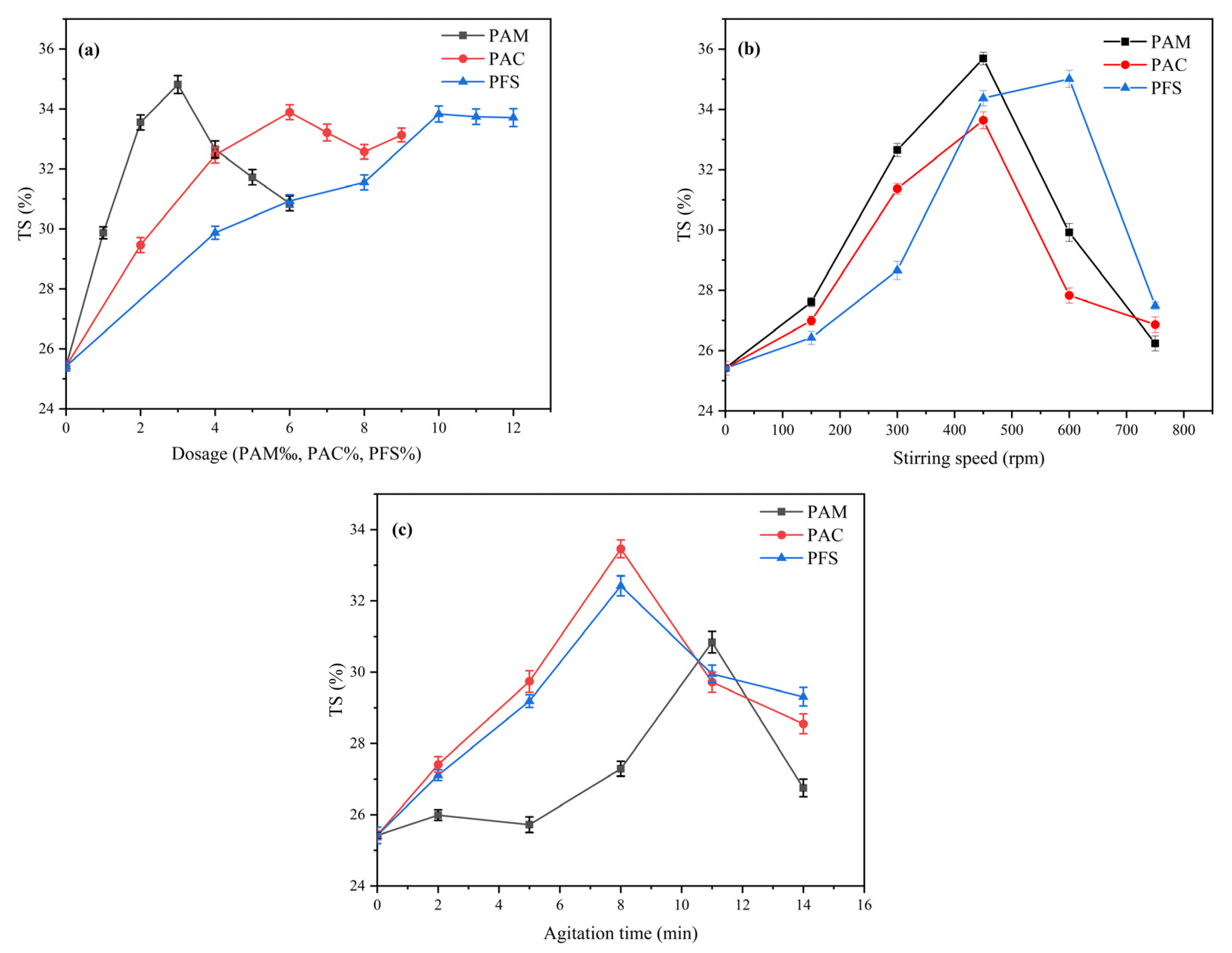
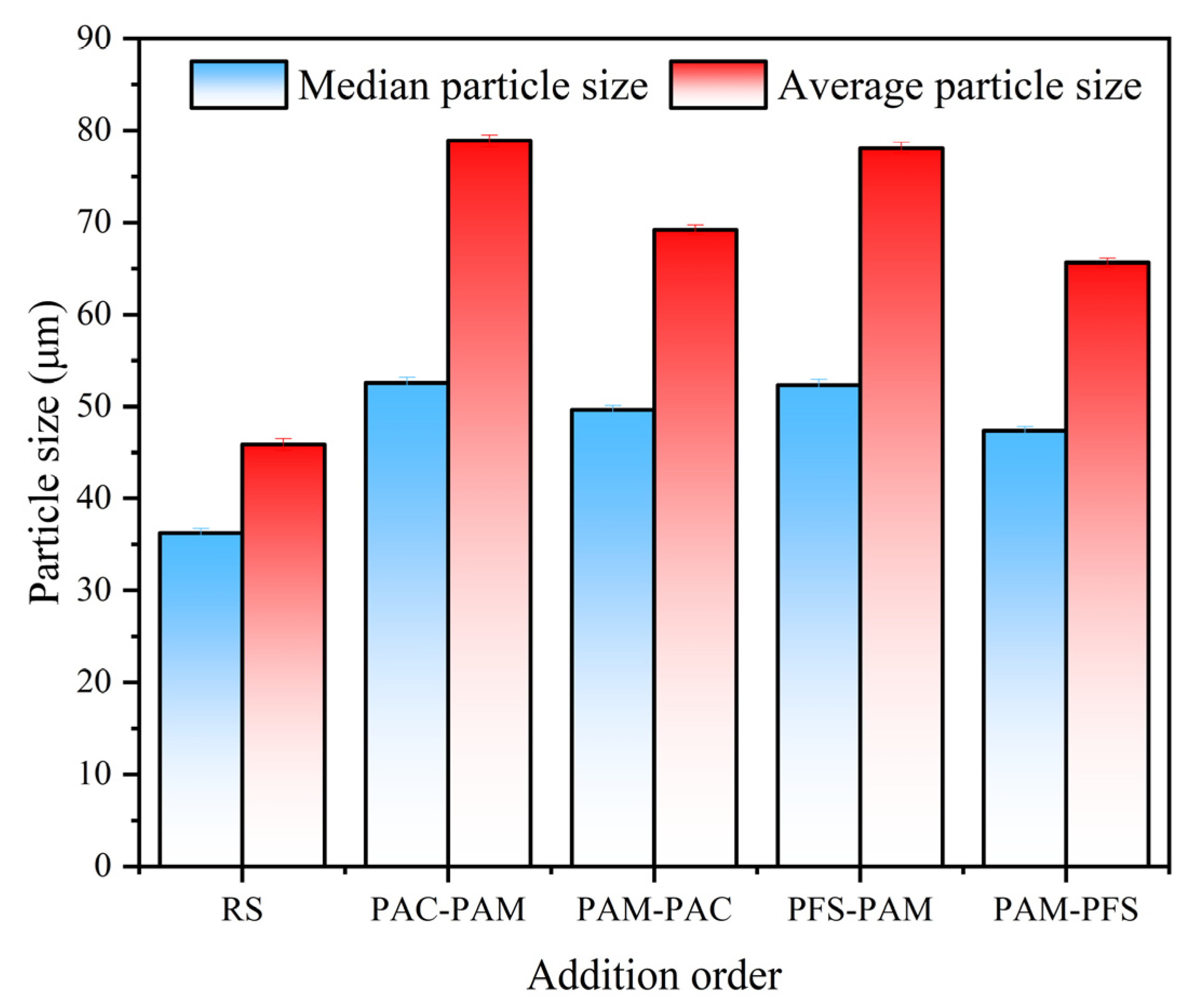


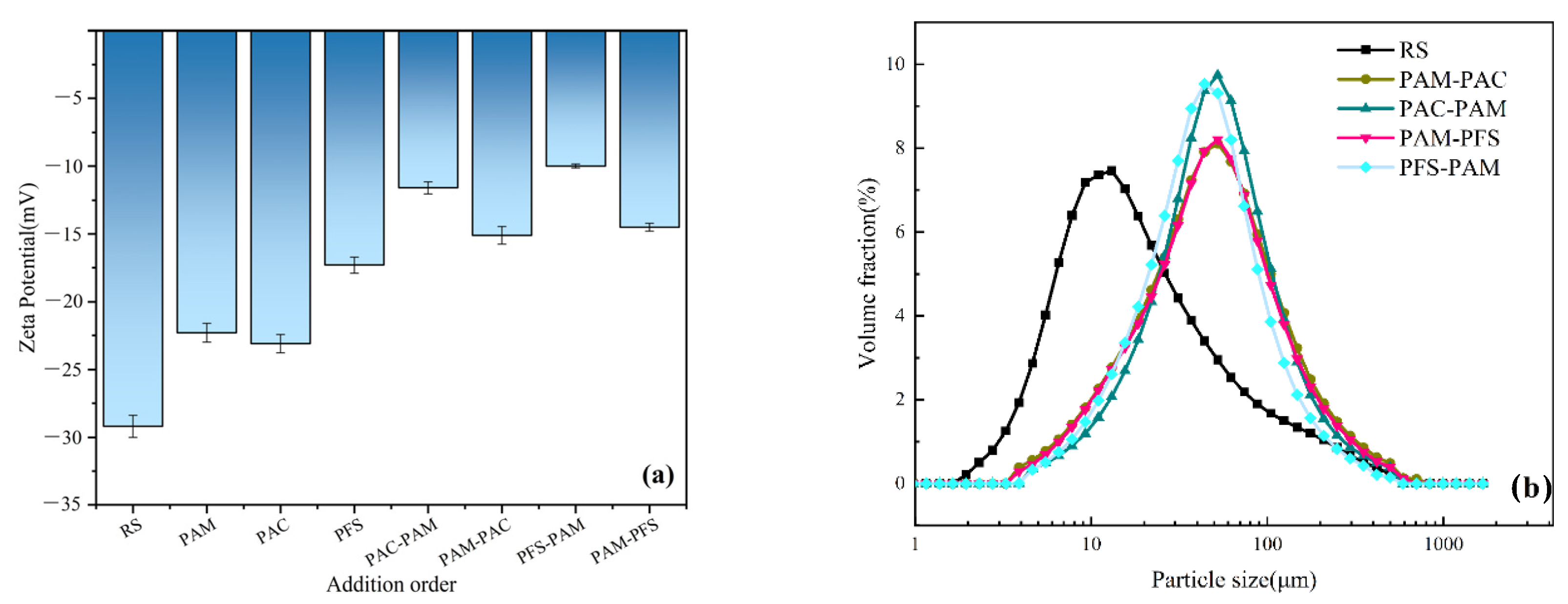
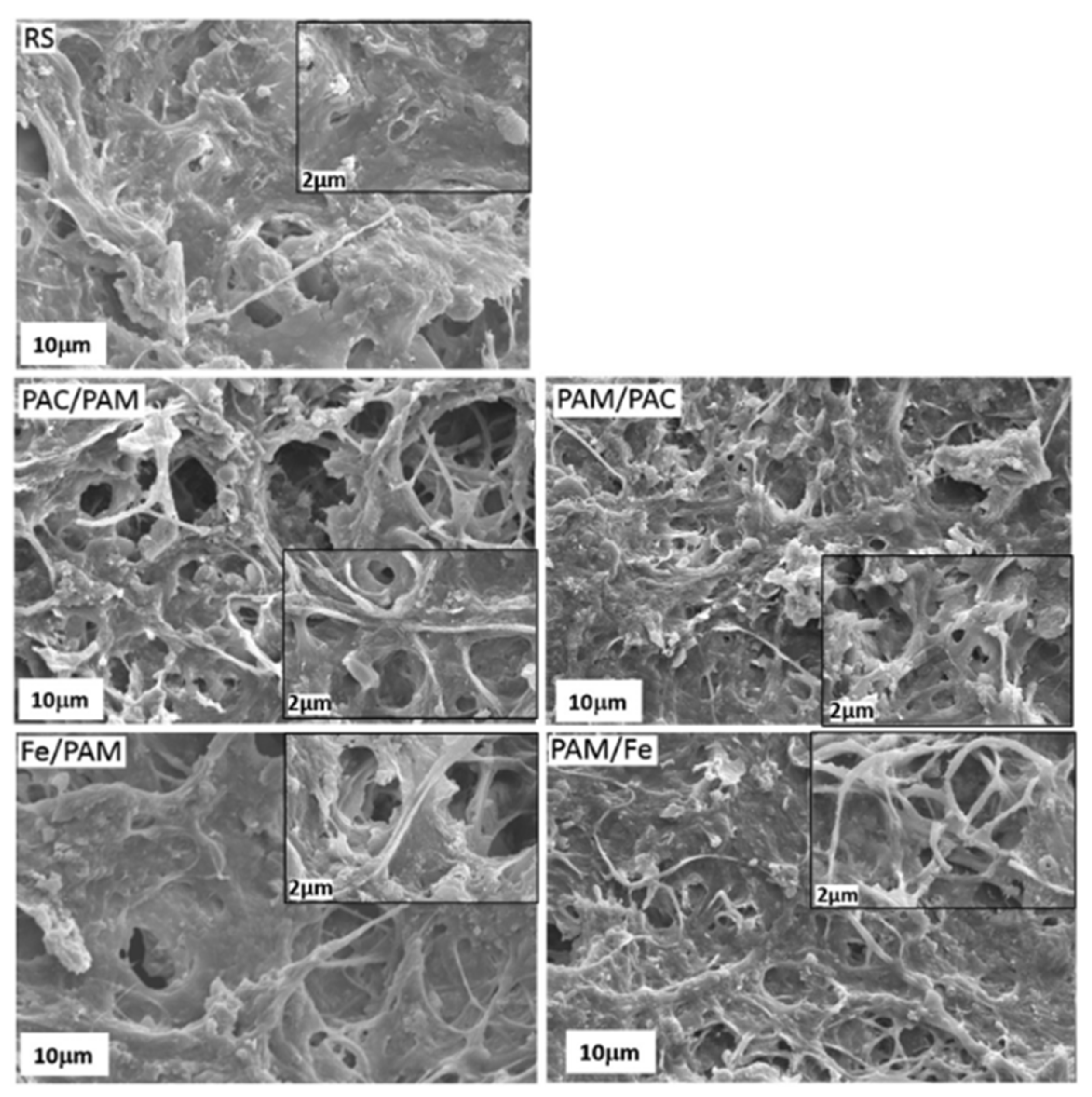
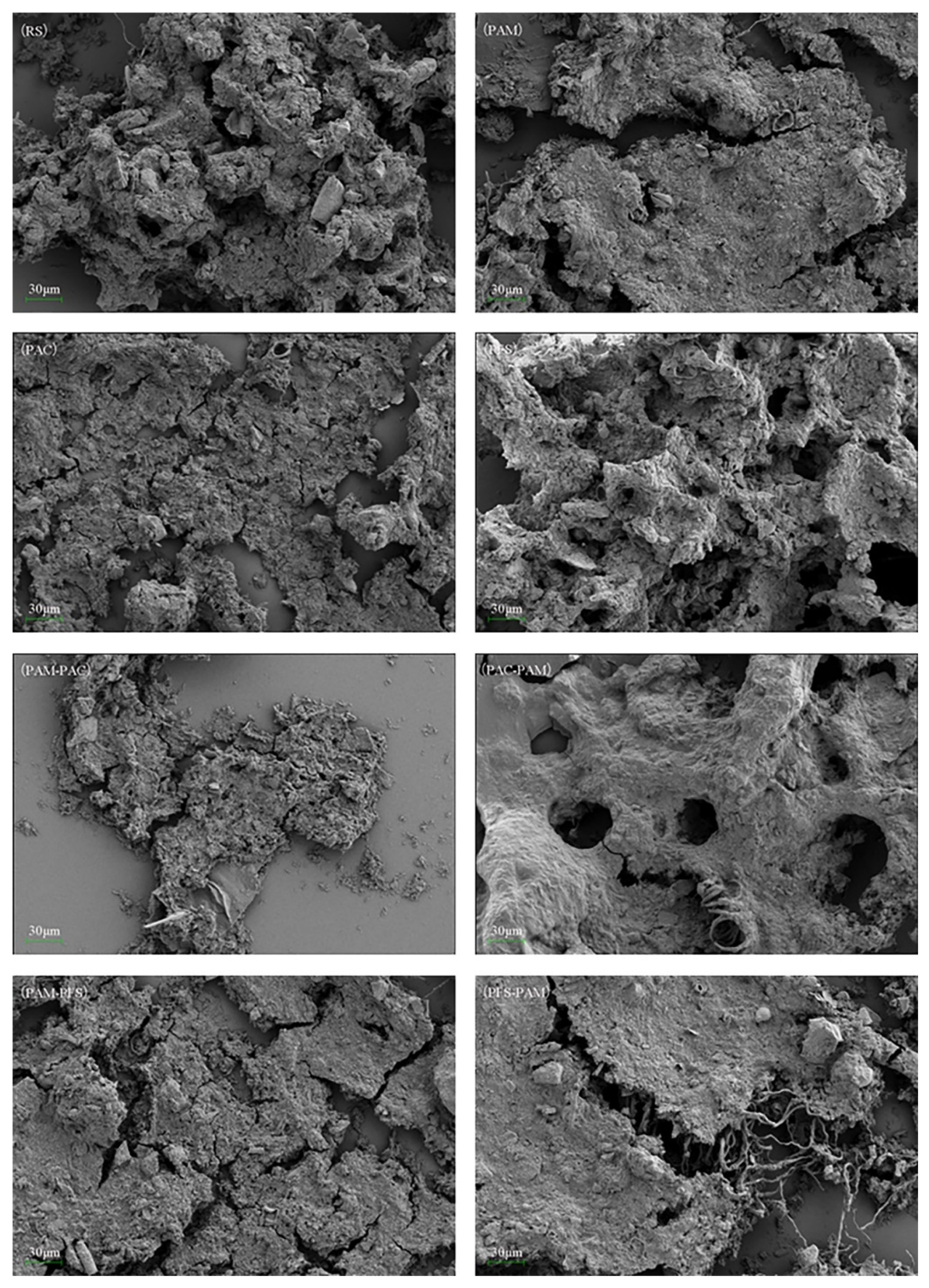

| Pre-Treatment Methods for Sludge Dewatering | Advantages | Disadvantages |
|---|---|---|
| Addition of porous materials | Changes the floc structure to enhance flocculation | Increases the final volume of dewatered sludge, leading to higher treatment costs. |
| Ultrasonic | Enhances the decomposition of flocculants. | Generates additional water-binding surfaces, resulting in a lower dewatering rate. |
| Alkaline treatment | Alters the floc structure of sludge to become more hydrophobic. | Increases the volume of sludge, leading to corrosion effects. |
| Heat treatment | Enhances hydrolysis capability to hydrolyze sludge flocs. | The existence of the Maillard reaction can lead to the generation of wastewater rich in complex nitrogen-containing compounds that are difficult to treat. |
| Electrochemical treatment | Utilizing osmotic pressure and electrolysis to degrade EPS can improve the efficiency of removing free water and bound water. | High energy consumption, corrosion of electrodes, and expensive maintenance costs. |
| Conditioning agent | Economical, good dewatering effect, without additional increase in sludge mass and external water-binding surfaces. | The impact of filtrate recycling. |
| Sludge Samples | Fitting Parameters | ||||
|---|---|---|---|---|---|
| τ0 (Pa) | K (Pa·sn) | n | R2 | Ultimate Viscosity (Pa·s) | |
| RS | 2.60838 | 0.03241 | 0.75443 | 0.96694 | 0.02260 |
| PAM-PAC | 1.66037 | 0.13096 | 0.71736 | 0.98317 | 0.02181 |
| PAC-PAM | 1.67007 | 0.11747 | 0.73172 | 0.99141 | 0.02113 |
| PAM-PFS | 2.54025 | 0.01733 | 0.99315 | 0.97910 | 0.02045 |
| PFS-PAM | 2.58787 | 0.01668 | 0.99379 | 0.96656 | 0.02002 |
| RS | PAM-PAC | PAC-PAM | PAM-PFS | PFS-PAM | |
|---|---|---|---|---|---|
| Thixotropic kinetic coefficients K | 0.00708 | 0.00480 | 0.00462 | 0.00459 | 0.00442 |
| Goodness of fit (R2) | 0.91405 | 0.98392 | 0.97889 | 0.97516 | 0.96637 |
Disclaimer/Publisher’s Note: The statements, opinions and data contained in all publications are solely those of the individual author(s) and contributor(s) and not of MDPI and/or the editor(s). MDPI and/or the editor(s) disclaim responsibility for any injury to people or property resulting from any ideas, methods, instructions or products referred to in the content. |
© 2024 by the authors. Licensee MDPI, Basel, Switzerland. This article is an open access article distributed under the terms and conditions of the Creative Commons Attribution (CC BY) license (https://creativecommons.org/licenses/by/4.0/).
Share and Cite
Cao, X.; Yu, R.; Wang, X. Impact of Conditioning Agent Addition Sequence on Dewatering Performance of Advanced Anaerobic Digested Sludge. Water 2024, 16, 695. https://doi.org/10.3390/w16050695
Cao X, Yu R, Wang X. Impact of Conditioning Agent Addition Sequence on Dewatering Performance of Advanced Anaerobic Digested Sludge. Water. 2024; 16(5):695. https://doi.org/10.3390/w16050695
Chicago/Turabian StyleCao, Xiuqin, Ran Yu, and Xin Wang. 2024. "Impact of Conditioning Agent Addition Sequence on Dewatering Performance of Advanced Anaerobic Digested Sludge" Water 16, no. 5: 695. https://doi.org/10.3390/w16050695
APA StyleCao, X., Yu, R., & Wang, X. (2024). Impact of Conditioning Agent Addition Sequence on Dewatering Performance of Advanced Anaerobic Digested Sludge. Water, 16(5), 695. https://doi.org/10.3390/w16050695






